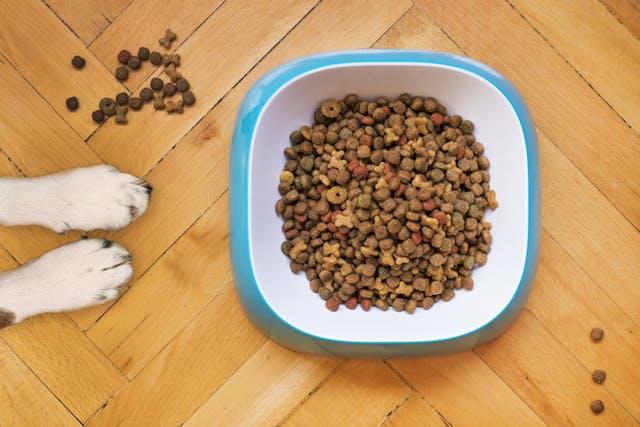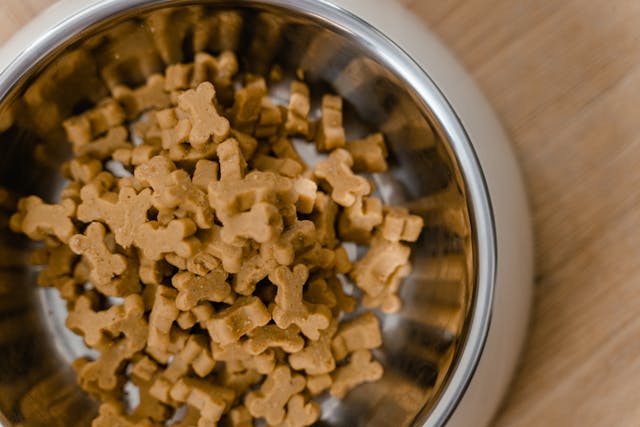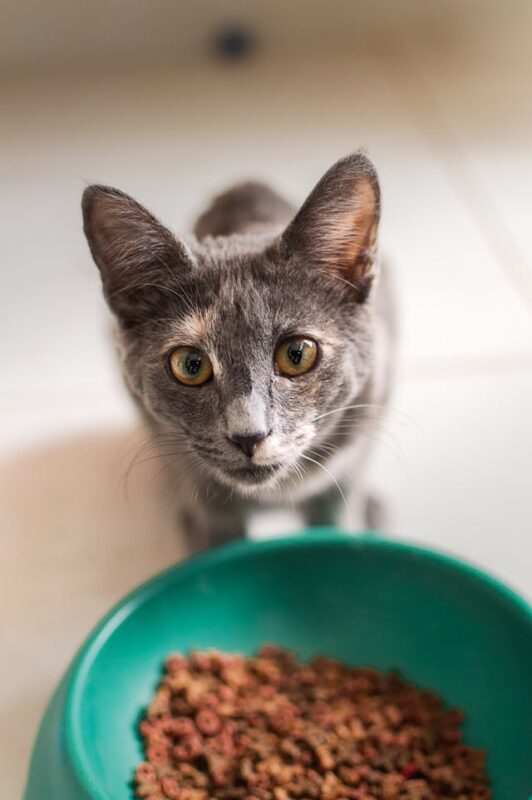Understanding Pet Food Labels: What’s Really in Your Pet’s Food?
Posted: 10/21/2024 | BY: Jenna Bruce | Categories: Pet care , Top Tips
When you grab a bag of pet food off the shelf, do you take a moment to flip it over and read the nutrition label? If the answer is “no,” don’t worry—you’re not alone! Pet food labels can feel like decoding an ancient language. But understanding what’s really in your pet’s food is crucial for making better choices and ensuring your furry friend gets the nutrition they need.

The First Ingredient: Protein Matters!
When you look at pet food labels, the first thing you should notice is the order. Ingredients are listed by weight, meaning the first ingredient is what makes up most of the food. For pets, protein is king. You want to see a quality animal protein, like chicken, beef, salmon, or lamb, as the first ingredient. These proteins are crucial for your pet’s muscle health, energy levels, and overall well-being.
But be careful! If the first ingredient is a protein “meal” or a vague term like “meat meal,” it’s not necessarily a bad thing. Meat meals are essentially dehydrated animal proteins, and while it may sound less appetizing to us, it packs a protein punch for your pet. Just make sure the label specifies the type of meat. “Chicken meal” is better than “meat meal,” which could come from a variety of less desirable sources.
Decoding the Fats: Healthy vs. Not-So-Healthy
Fats are essential for your pet’s health. They provide energy, support cell function, and help your pet absorb vitamins. But not all fats are created equal. Look for named fat sources like chicken fat or fish oil. These are high-quality fats that can benefit your pet’s skin and coat while offering essential fatty acids like omega-3 and omega-6.
On the flip side, you want to avoid generic terms like “animal fat.” This can be a catch-all term for a variety of less healthy fats from unnamed sources. The more specific the label, the better the quality of ingredients.

Carbs in Pet Food: What’s the Deal?
Pets—especially cats—don’t need a ton of carbohydrates in their diet. But carbs are often added to pet food as a cheap source of calories and to create the kibble texture that’s easy to store and serve.
So, what carbs should you look for? Whole grains like brown rice, barley, or oatmeal are generally better than cheap fillers like corn, wheat, or soy. Whole grains provide fiber, vitamins, and minerals that support your pet’s digestion and overall health.
Grain-free pet foods are popular, but it’s important to know that grain-free doesn’t mean carb-free. Many grain-free foods use alternative sources like potatoes, peas or fruits for carbs. While these ingredients are okay in moderation, if they’re at the top of the ingredient list, your pet may be getting more starches than they need.
The Truth About By-Products
Oh, the dreaded “by-products.” If you see this term, you might think you’re feeding your pet the leftovers of a mystery meat. But don’t be too quick to dismiss by-products. In reality, chicken by-products or beef by-products are organ meats like liver, kidneys, and lungs, which can be nutritious for pets. These organs are packed with vitamins and minerals that are beneficial to their health.
The key is specificity. If the label says “chicken by-products,” you’re in the clear. But if it says “animal by-products” without specifying the source, it could be anything from feathers to beaks. Always look for specifics!
Misleading Terms to Watch For
Pet food companies are marketing pros that know how to make their products sound irresistible—even if they’re not the healthiest option. Let’s break down some common buzzwords that may not mean what you think.
- Natural: This label sounds like a winner, right? “Natural” on pet food means the ingredients are derived from plant, animal, or mineral sources and are minimally processed. But here’s the catch—“natural” doesn’t always mean it’s good for your pet. A pet food labeled as “natural” can still include fillers, unhealthy fats, and low-quality proteins. Always check the ingredient list to ensure it truly provides the nutrients your pet needs.
- Holistic: Here’s a fun fact: there’s no legal definition for “holistic” when it comes to pet food. It’s essentially a marketing term, and it doesn’t guarantee that the food is better for your pet than others. Don’t be swayed by the term “holistic” alone. Always read the ingredient list and look for high-quality proteins, healthy fats, and essential nutrients. Consult with your veterinarian to choose food that meets your pet’s specific health needs rather than relying on vague marketing terms.
- Premium or Gourmet: These terms may make you feel like you’re treating your pet to something fancy, but they don’t have any regulatory meaning. Premium doesn’t necessarily mean high-quality, though the manufacturer wants you to think it does. Always check the ingredient list to see if the product lives up to its label.
- Complete and Balanced: This is a term regulated by the Association of American Feed Control Officials (AAFCO), so it’s actually meaningful. It means the food contains all the essential nutrients your pet needs. Look for this term on any pet food you buy.
Vitamins, Minerals, and Additives—Oh My!
Beyond the basic ingredients, you’ll often see a list of added vitamins and minerals on pet food labels. These are crucial for your pet’s health, so don’t skip over them. Look for vitamin E, vitamin D, calcium, and zinc to ensure your pet is getting the nutrients they need.
However, be wary of artificial additives like BHA, BHT, or ethoxyquin. These are preservatives that have been linked to health issues in some studies. Instead, look for natural preservatives like mixed tocopherols (vitamin E) and ascorbic acid (vitamin C).
The Bottom Line: How to Choose the Best Food for Your Pet
Now that you’re an expert in reading pet nutrition labels, here’s a quick guide to making the best choice for your furry friend:
- Check the first ingredient. Look for a named animal protein like chicken, beef, or salmon.
- Watch out for fillers. Avoid foods where corn, soy, or wheat are at the top of the ingredient list.
- Pick healthy fats. Go for named sources like chicken fat or fish oil and avoid generic “animal fats.”
- Understand by-products. Not all by-products are bad. Just make sure the source is named.
- Beware of marketing buzzwords. Terms like “natural,” “premium,” and “holistic” sound great but may not mean much. Look for “complete and balanced” for assurance.
- Avoid artificial preservatives. Opt for foods preserved with natural ingredients like tocopherols or ascorbic acid.
Wrapping It Up
Feeding your pet should be an act of love, and part of that love is knowing what’s really in their food. Now that you’re equipped with the knowledge to decode those tricky pet food labels, you can make smarter, healthier choices for your four-legged family member. They may not be able to thank you in words, but those happy tail wags or purring cuddles say it all!
Thinking About Pet Insurance?
Protect your furry family member with the care they deserve! Enroll your pet in a pet insurance plan today and enjoy peace of mind knowing you’re prepared for unexpected vet visits, treatments, and emergencies. Give your pet the best possible care without the financial stress—because they’re worth it!
Thinking of insuring your pet?
Get Quotes & CompareReferences:
- https://www.aafco.org/consumers/understanding-pet-food/reading-labels/
- https://www.akc.org/expert-advice/nutrition/how-to-read-a-dog-food-label/
- https://vcahospitals.com/know-your-pet/deciphering-dog-food-labels
Disclaimer
The information contained on this blog is intended for informational and educational purposes only and should not be construed as medical advice. It is not a substitute for professional veterinary care. Always consult with your veterinarian before making any changes to your pet's health care or treatment plan.
The authors of this blog are not veterinarians and do not claim to be experts in pet health. The information provided here is based on our own experiences and research, as well as information from reputable sources. However, we cannot guarantee the accuracy or completeness of this information.
We encourage you to do your own research and consult with your veterinarian before making any decisions about your pet's health.
Previous post
The Bulldog Lifespan: A Guide for Pet ParentsNext post
The Power of Play: Keeping Pets HealthyCompare top pet insurance providers & plans.
Enter your dog’s age in years and months to calculate their age equivalent to human years.
Calculate your dog’s ageEnter your cat’s age in years and months to calculate their age equivalent to human years.
Calculate your cat’s age

